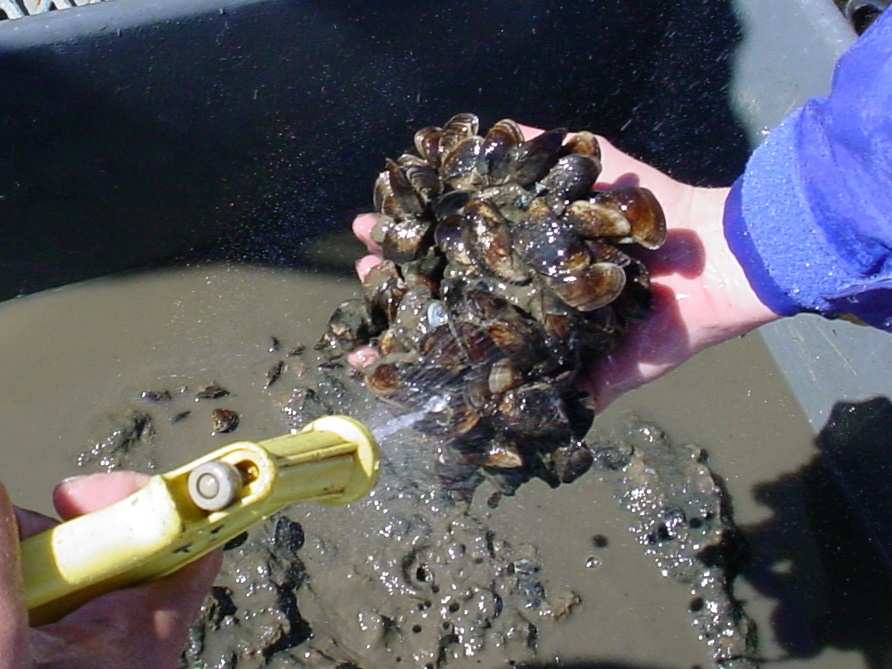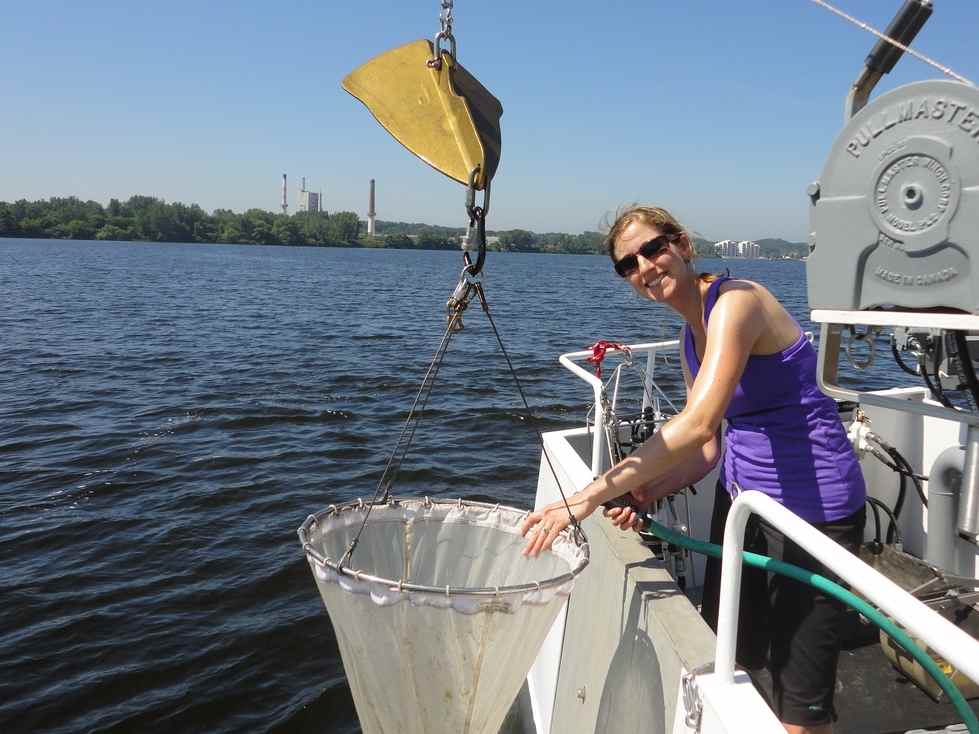Muskegon Lake Long-Term Monitoring Project

Dreissena mussels collected in a Muskegon Lake sediment sample
[1406824896].jpg)
Fyke nets are used to monitor the fish community

Yellow perch captured in Muskegon Lake
Muskegon Lake is a highly disturbed ecosystem listed as an Area of Concern (AOC) in the Great Lakes region. Yet there is a surprising lack of recent information on Muskegon Lake. Detailed and long-term understanding of the lake ecology is essential for wise management of this vital coastal ecosystem that connects the landscape (Muskegon River watershed) to the Lake Michigan.
In 2003, AWRI initiated a long-term monitoring program in Muskegon Lake. An endowment fund at the Community Foundation for Muskegon County, started through the generosity of donors in the greater Muskegon region, helps defray the costs of this project. As residents on the lake, we feel both a responsibility and an obligation to monitor and research the ecological health of this water body. This information is being used to track the restoration and recovery of the lake and, ultimately, demonstrate that it meets the criteria to be removed from the AOC list. Through our monitoring program, we inform the community on the lake's status, provide a foundation for student and faculty research projects, and have leveraged over $10 million in additional funding.
Main Goals
- Observe short-term and long-term changes in the ecological health of Muskegon Lake.
- Understand the mechanisms behind the changes we see in the lake's ecology.
- Integrate Muskegon lake ecology to the watershed level, and to society at large.
- Use the information generated from this study to remove (de-list) Muskegon Lake as one of the Areas of Concern (AOC) in the Great Lakes.

Six sites are being sampled for water quality 3 times per year for a suite of physical, chemical, and biological parameters. Chemical/physical parameters include nutrients (nitrogen and phosphorus), dissolved oxygen, temperature, light transmittance, and Secchi depth. Biological sampling includes measurements of the algal, benthic invertebrate, and fish communities.
As a complement to the long-term monitoring program, the Muskegon Lake Observatory (www.gvsu.edu/wri/buoy) was established in 2011. The observatory consists of a buoy system that collects continuous water quality, hydrology, and meteorological data during the ice-free period.
Each year the monitoring results are communicated to the community in the form of a water quality dashboard based on key water quality indicators.
Monitoring data
- Muskegon Lake Water Quality Dashboard
- Our long-term monitoring data are available upon request and subject to Director approval. Please contact Mike Hassett for further information: [email protected]
- Additional Muskegon Lake data can be downloaded from the Muskegon Lake Observatory website.
Publications
- Weinke, A.D., S.T. Kendall, D.J. Kroll, E.A. Strickler, M.E. Weinert, T.M. Holcomb, A.A. Defore, D.K. Dila, M.J. Snider, L.C. Gereaux, B.A. Biddanda. 2014. Systematically variable planktonic carbon metabolism along a land-to-lake gradient in a Great Lakes coastal zone. Journal of Plankton Research 36: 1528-1542.
- Altenritter, M.E.L., A.C. Wieten, C.R. Ruetz III, and K.M. Smith. 2013. Seasonal spatial distribution of juvenile lake sturgeon in Muskegon Lake, Michigan, USA. Ecology of Freshwater Fish 22:467-478.
- Nelson, W. and A.D. Steinman. 2013. Changing trends in benthic communities in a coastal drowned river mouth lake, a Great Lakes Area of Concern. Journal of Great Lakes Research 39: 7-18.
- Bhagat, Y., and C.R. Ruetz III. 2011. Temporal and fine-scale spatial variation in fish assemblage structure in a drowned river mouth system of Lake Michigan. Transactions of the American Fisheries Society 140:1429-1440.
- Gillett, N. and A.D. Steinman. 2011. An analysis of long-term phytoplankton dynamics in Muskegon Lake, a Great Lakes Area of Concern. Journal of Great Lakes Research 37: 335-342.
- Janetski, D.J., C.R. Ruetz III, Y. Bhagat, and D.F. Clapp. 2013. Recruitment dynamics of age-0 yellow perch in a drowned river mouth lake: assessing synchrony with nearshore Lake Michigan. Transactions of the American Fisheries Society 142:505-514.
- Ruetz, C.R., III, D.L. Strouse, and S.A. Pothoven. 2009. Energy density of introduced round goby compared with four native fishes in a Lake Michigan tributary. Transactions of the American Fisheries Society 138:938-947.
- Biddanda, B.A., A. Steinman, L. Nemeth, Y. Hong and S. Kendall. 2008. Nutrient bioassays of plankton biomass and metabolism in an urbanized drowned river-mouth lake (Mona Lake, Michigan). Journal of Freshwater Ecology 23: 41-53.
- Ruetz, C.R., III, D.G. Uzarski, D.M. Krueger, and E.S. Rutherford. 2007. Sampling a littoral fish assemblage: comparing small-mesh fyke netting and boat electrofishing. North American Journal of Fisheries Management 27:825-831.
- Hong, Y., A. Steinman, B. Biddanda, R. Rediske, and G. Fahnenstiel. 2006. Occurrence of the toxin-producing cyanobacterium Cylindrospermopsis raciborskii in Mona and Muskegon Lakes, Michigan. Journal of Great Lakes Research 32: 645-652.
- Steinman, A.D. and M. Ogdahl. 2004. An innovative funding mechanism for the Muskegon Lake Area of Concern. Journal of Great Lakes Research 30: 341-343.
- Steinman, A.D., M. Ogdahl, R. Rediske, C.R. Ruetz III, B.A. Biddanda, and L. Nemeth. 2008. Current status and trends in Muskegon Lake, Michigan. Journal of Great Lakes Research 34: 169-188.
- Xie, L., J. Hagar, R.R. Rediske, J. O’Keefe, J. Dyble, and A.D. Steinman. 2011. The influence of environmental conditions and hydrologic connectivity on cyanobacteria assemblages, including Cylindrospermopsis raciborskii, in two drowned river mouth lakes. Journal of Great Lakes Research 37: 470-479.
Special thanks to Dr. William Jackson (deceased) and the Muskegon Sportfishing Association for their generous gifts to the endowment.
Contacts
Al Steinman, Project Manager: [email protected]
Ryan Otter, Water Chemistry: [email protected]
Bopi Biddanda, Microbiology: [email protected]
Carl Ruetz, Fish Biology: [email protected]
Mike Hassett, Data Management and Sampling: [email protected]

